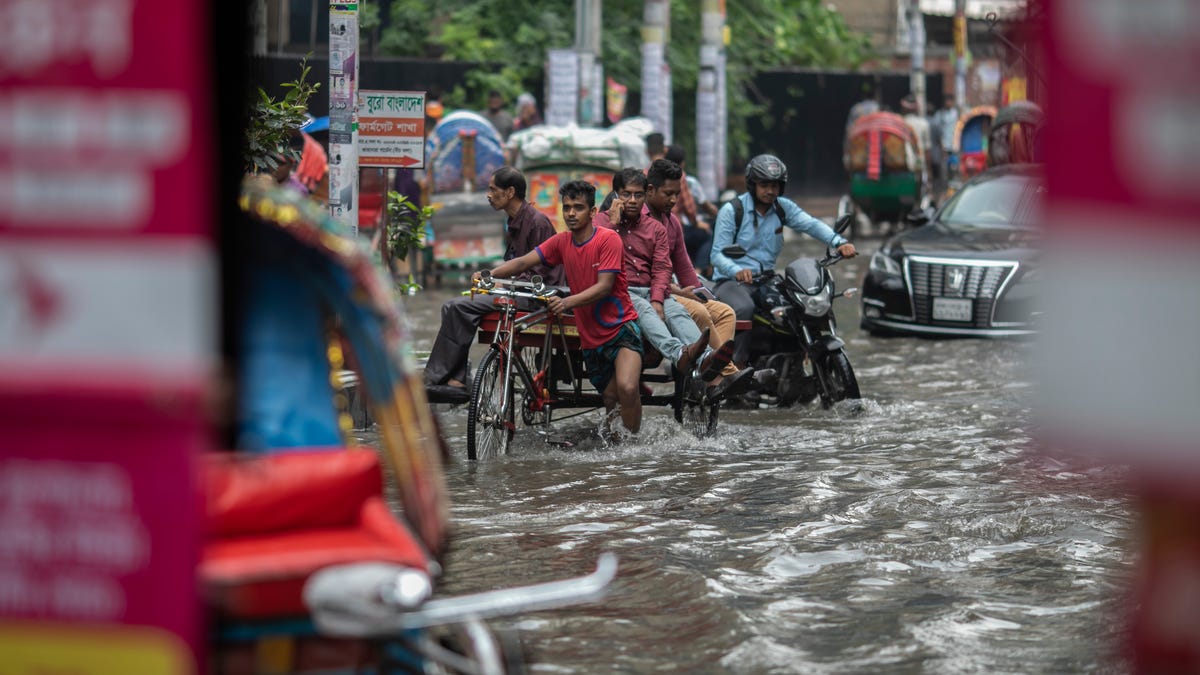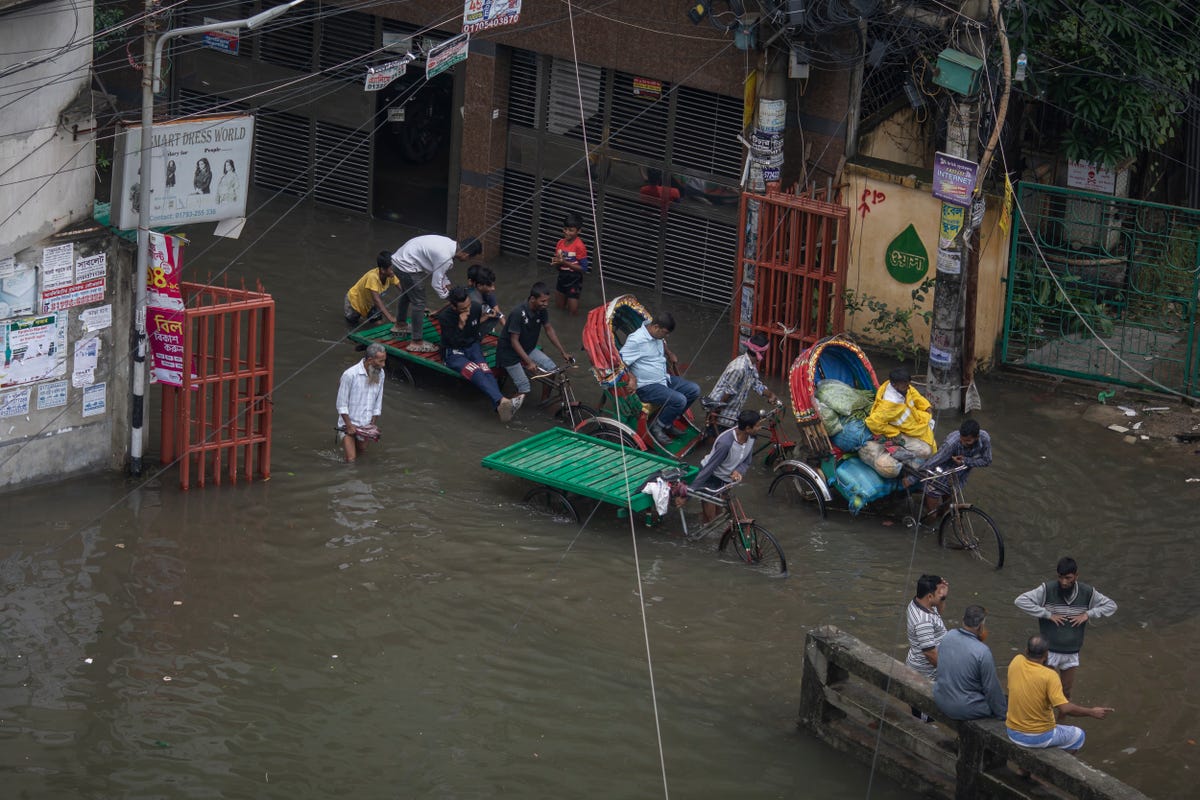
A rickshaw several passengers through the flooded streets of Dhaka after heavy monsoon rain in October 2022. Climate change is known to make monsoons more erratic and dangerous.
Sazzad Hossain/SOPA Images/LightRocket via Getty Images
On Monday, scientists announced the alarming results of a study that looked at how climate change impacts the mental health of people who live in Bangladesh – a country considered one of the most vulnerable to devastation from the crisis, yet one of the least responsible for it.
First, the team measured climate variables at 43 weather stations in Bangladesh to track parameters such as seasonal temperature, humidity and flooding occurrences over two months. Then they surveyed 7,000 citizens in both urban and rural areas first in August and September 2019, and then again in January and February 2020, to assess how subjects’ anxiety and depression changed amid weather fluctuations tied to global warming.
The results revealed that people who experienced higher temperatures (by 1 degree Celsius) during the two months preceding the study had a 21% higher probability of having an anxiety disorder and a 24% higher probability of having depression.
The team’s paper, published in the journal Lancet Planetary Health, also suggested that an increase in humidity (specifically, a 1 gram of moisture increase per cubic meter of air) created a 6% higher probability of having both anxiety and depression, too.
And in terms of natural disasters, the study found climate change-induced flooding led to an increased probability of depression by 31%, anxiety by 69% and both together by a staggering 87%.
“We have now established a high-water mark that alas could soon be eclipsed for how climate can impact mental health in a highly vulnerable country. This should serve as a warning for other nations,” Syed Shabab Wahid, an assistant professor in the department of global health at Georgetown University’s School of Health and lead author of the study, said in a statement.
This study adds to a growing body of research surrounding climate change’s impacts on mental health, highlighting once again how this crisis seems to be touching all aspects of our lives. In June of last year, the World Health Organization presented a policy brief urging all countries to incorporate some sort of mental health support in their crisis relief plans.
“As climate change worsens, temperatures and humidity will continue to increase, as will natural disasters, such as extreme flooding, which portends worsening impact on our collective mental health, globally,” Wahid said.
But what’s especially concerning for Bangladesh is that things like temperature increases, humidity increases and excessive flooding are all bound to seriously ramp up there as climate change, driven in large part by the burning of fossil fuels, gets harsher. Already, many coastal areas undergo cyclones twice annually due to the rate at which our planet is heating up – disasters that destroy homes and result in shocking amounts of death.


People with rickshaws struggle through a waterlogged street following heavy rains. When Cyclone Sitrang hit Bangladesh, it snapped communications and power links, and it flooded streets, bringing activities to a standstill.
Sazzad Hossain/SOPA Images/LightRocket via Getty Images
To make matters worse, many scientists say that our current climate trajectory – including progress we’ve made thus far in mitigating global warming – is really not looking good. So it’s quite likely that the mental health risks uncovered by Wahid and his fellow researchers could be hinting at a much more tragic conclusion than they seem to on the surface. Especially considering how the study was conducted several years ago, when climate change’s consequences were relatively “better,” per se.
“Our next steps are twofold. We want to develop and evaluate community-based interventions that are culturally appropriate for Bangladesh, such as offering mental health services to climate-affected communities, of which there are many throughout the country,” Wahid said.
“We also plan to conduct further research in Bangladesh,” he said. “And globally on the associations identified in this study using longer-term approaches to narrow down the causes and effects of climate changes on mental health.”
However, it’s worth nothing that for vulnerable countries such as Bangladesh to implement interventions money is a limiting step.
It’s not always easy to find financial support when most of your nation’s climate budget must be spent on housing people whose homes were ravaged by cyclones and on preventing death. Per a press release published last year by the World Bank – an organization that helped fund Wahid’s study – average tropical cyclones cost Bangladesh about $1 billion annually.
More than a decade ago, during a major climate conference in Copenhagen called COP15, industrialized nations formally promised to deliver a collective $100 billion every year to aid developing nations starting in 2020 and ending in 2025. That’s a total of $500 billion. It sounds like a lot, but this sum is actually now deemed conservative.
Then in 2020, that $100 billion promise slipped out of reach, as the loaner countries argued over complicated caveats like who owes what and how everything will be delivered.
At the end of the day, only about $83 billion was officially scraped together to help developing countries.
On the bright side, during last year’s COP27, industrialized countries finally established a funding mechanism to deliver money to help developing nations contend with the crisis. This was a huge win. But as United Nations Secretary General António Guterres said soon after, “Clearly this will not be enough, but it is a much-needed political signal to rebuild broken trust.”
